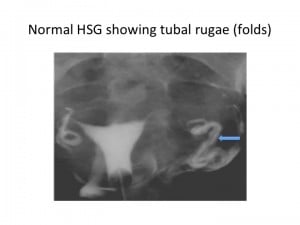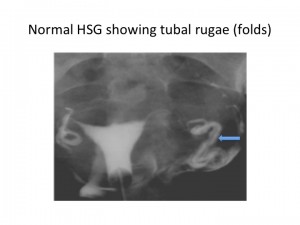We are experiencing a very high volume of calls and messages and ask for your patience. We will answer your portal messages within 48 hours.
We are experiencing a very high volume of calls and messages and ask for your patience. We will answer your portal messages within 48 hours.

A hysterosalpingogram (hystero = uterus; salpingo = fallopian tubes; gram = X-ray) or HSG is a simple procedure where X-rays are used to evaluate the uterus and the fallopian tubes.
 A HSG is a routine test done as part of an infertility work-up. It is to be done in the first half of the cycle so that we can be sure that the patient is not pregnant. In experienced hands, a HSG is quick, efficient and can be painless.
A HSG is a routine test done as part of an infertility work-up. It is to be done in the first half of the cycle so that we can be sure that the patient is not pregnant. In experienced hands, a HSG is quick, efficient and can be painless.
In this post, I explain why we might use HSG, how we administer it, what we can learn from it, and what its limitations are when it comes to helping us find out why you're having trouble getting pregnant..
The patient lies on her back with her legs in stirrups. A pelvic exam is often performed. A vaginal speculum is inserted to expose the cervix, which is then held with an instrument (single-toothed vulsellum). A local anesthetic can be given around the cervix (paracervical block). A plastic canulla is inserted through the cervix into the uterine cavity where its balloon is inflated to hold it in place. A radio-opaque dye is then (gently) injected into the uterus through the canulla. As the dye is being injected, serial X-ray pictures are taken. These can later be viewed in great detail. Once the procedure is completed, the vaginal instruments are removed. The entire process takes only a few minutes.
Patients may experience some cramping as the dye is being injected. This can be worse if the tubes are blocked and there is resistance to the dye flowing through. We encourage our patients to take ibuprofen 800 mg a few minutes prior to the procedure.
A HSG is a very safe procedure and has been done for many decades. There are always risks with every procedure. Some of the very rare complications associated with HSG include:
It is now possible to use special catheters (selective salpingography and wire guides) to open up blocked tubes at the time of diagnosis. We specialize in this "tubal catheterization" procedure and I will write a blog about it in the near future.
A HSG only gives information about the inside of the uterine cavity. You could have fibroids in the uterine wall and these will not be seen on HSG. Also, it is not possible to visualize the ovaries on HSG. At InVia Fertility Specialists, we use a combination of HSG and ultrasound to complete a thorough investigation of the pelvic structures.
An additional advantage of HSG is that it can increase the chance of a spontaneous pregnancy! Just the “flushing open” of the tubes may enhance your fertility!
To see a Board Certified physician who has been successfully treating intrauterine adhesions for many years, make an appointment at one of InVia's four Chicago area fertility clinics.
Infertility Infertility treatment InVia Fertility Specialists

Entire Website © 2003 - 2020
Karande and Associates d/b/a InVia
Fertility Specialists
